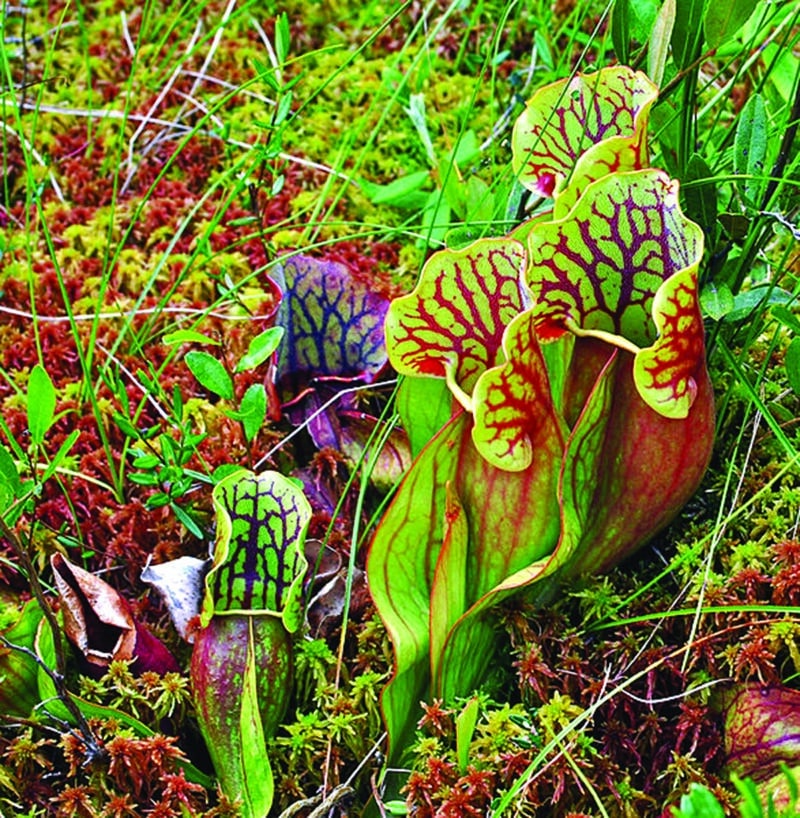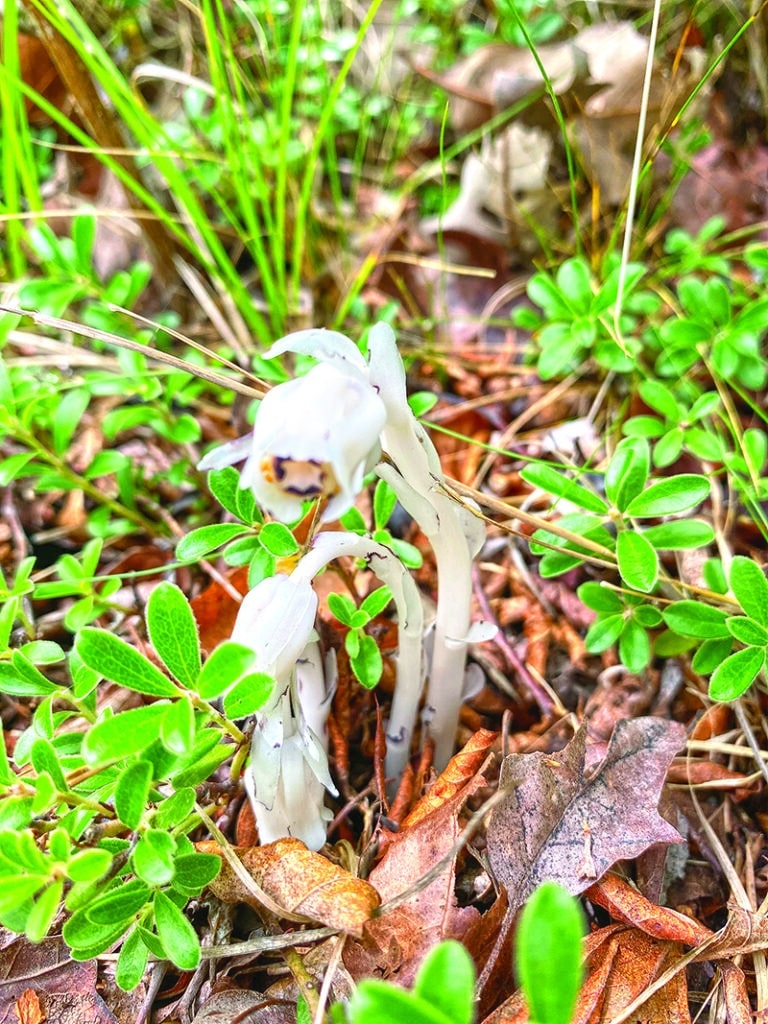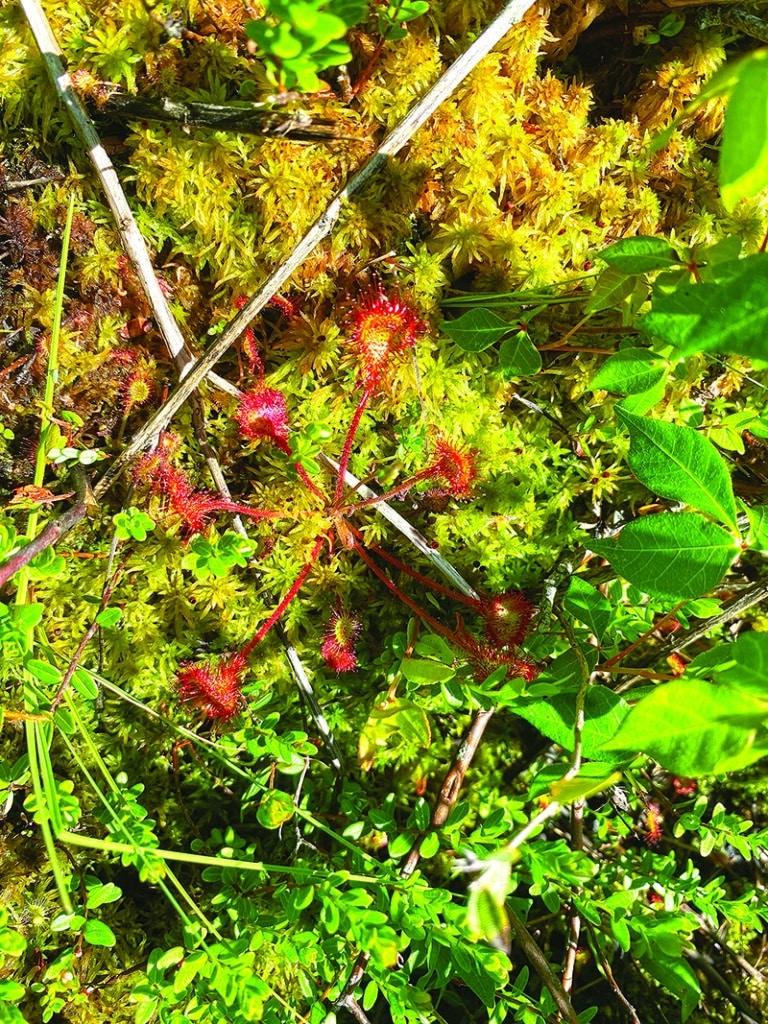by Dr. Sarah Treanor Bois, PhD
Director of Research & Education at the Linda Loring Nature Foundation
It sounds like something out of a movie: predatory plants. This has me thinking zombies, Venus fly traps, body snatchers, and, possibly, giant dog-eating vines (Feed me Seymore!). However, predatory plants are not a foreign concept. In fact, there are multiple plants found around Nantucket that exhibit predatory behavior.
In general, plants get energy via two different strategies: most are autotrophs, making their own energy, and others are heterotrophs. We generally know plants as autotrophs because it’s the strategy most plants use, making energy from the sun via photosynthesis. Other autotrophs, more rarely, obtain chemical energy through oxidation. But we’re here to talk about those that cannot make their own food.
Heterotrophs are consumers which depend on other sources for their food (pssst – we are heterotrophs). Plant heterotrophs cannot perform photosynthesis. The group of plants found on Nantucket that we can call “predatory plants” generally find food in two ways: by being parasitic or carnivorous. These fascinating plants can be found across Nantucket Island, so let’s dive into a few examples.
About 1% of all flowering plants in the world (around 4,000 species) are parasitic, meaning they steal nutrients from other plants. One easy way to identify these primarily non-photosynthetic plants is that they aren’t green.
A favorite parasitic plant is dodder vine, an orange, vegetative vine often found around the cranberry bogs. Dodders (Cuscuta spp.) are obligate parasitic plants whose twining stems produce small clusters of white flowers. The orange or yellowish stems will wrap around the host and insert specialized structures (known as haustoria) into the host plant. The haustoria establish a physical connection between the dodder and the host that permits the withdrawal of nutrients and water from the host to the dodder plant. As dodder is an obligate parasite and cannot survive without a host, seedlings must find a host plant within 5-10 days before they run out of energy. To do so, they can sense which nearby plants would make the best hosts and actively grow in their direction. This seemingly delicate plant is truly a zombie (or maybe a vampire) in disguise. One species that we have on island, Buttonbush dodder (Cuscuta cephalanthi), uses a large number of herbaceous and shrubby species as host plants. Its common name derives from the fact that buttonbush (Cephalanthus) is one of these unfortunate hosts. Most dodder species are not host specific.
Scaldweed or common dodder (Cuscuta gronovii), is commonly found in the cranberry bogs and Windswept as well as Stump Pond. But does this parasite harm it’s host? Dodder ranges in severity based on its species and the type of host, the time of attack, and whether any viruses are also present in the host plant. For the cranberry bogs, it is a species that is actively managed for since it decreases yield. Otherwise, it isn’t known to wipe out its host plants.
Another favorite parasitic plant of the woods is the ghost plant (Monotropa uniflora). Also known as Indian pipe because of the plants resemblance to a peace pipe, ghost plants are often mistaken for fungi because of their pale, fleshy appearance. They typically occur in well-established forests and are often thought of as indicators of healthy ecosystems. It’s actually an herbaceous perennial flowering plant native to our region. At one time, it was believed that ghost plant absorbed nutrients from decayed organic material; however, this is not the case. We now know that ghost plant obtains its nutrients by tapping into the resources of trees, indirectly through myccorhizal fungi. The fungi acts as a sort of middleman that processes food delivery to the ghost plant from the surrounding green plant.
It’s a pretty good strategy to be parasitic and not rely on the sun when you grow in the deep, dark woods. The most notable part of ghost plant is the translucent, waxy white or pink flower; the nodding bloom is on a translucent stem with scale-like leaves. It usually blooms in our area in July, so keep an eye out on your woodsy walks. You can find these in the mesic woods of Squam Swamp and Squam Farm. You can also sometimes see them in winter as withered, black stems at the base of trees.
In contrast to the parasites, carnivorous plants trap and consume insects to supplement their nutrition. Our carnivorous plants do have chlorophyll and photosynthesize to some extent, but need additional nutrition which they attain via their carnivorous ways. On Nantucket these include pitcher plants (Sarracenia sp.), sundews (Drosera sp.), and bladderworts (Utricularia sp.).
Our native purple pitcher plant (Sarracenia purpurea, cover photo) is found amongst sphagnum mosses in bogs or other acidic wetlands and is the only pitcher plant species native to New England. They can be found in the kettle hole bogs of the Middle Moors like Donut Bog and Taupawsha, among other areas. Pitcher plants are named for the pitcher-shaped leaves which hold water and trap insects. Insects are attracted into the lurid red or purple pitchers, and are then prevented from getting out by downward-pointing hairs. Prey drown in the rainwater that collects in the base of each leaf. The rain water is mixed with digestive enzymes which the plant secretes to digest trapped insects, supplying much-needed nitrogen for a plant adapted to nutrient-poor bog conditions. Other carnivorous plants are also found in boggy and nitrogen-deficient conditions.
I love the various sundew species found around our freshwater wetlands and bogs. They look like tiny seedlings with red threads covered in fine dew drops. The fairy-like, delicate-looking plants bely the deadly juices that cover the leaves. What looks like a fresh spring dew is actually a sticky, digestive sap which attracts, traps, and then slowly digests prey. We have three species on-island; the roundleaved sundew (Drosera rotundifolia), the spatulate-leaved sundew (Drosera intermedia), and the thread-leaved sundew (Drosera filiformis). Sundews are closely related to Venus fly traps and have a similar trigger movement. Insects stuck to the sap struggle, causing the sticky leaf to fold over the insect, trapping it for digestion. Although insect prey is not vital to sundew’s survival, research has shown that sundews that are successful tend to thrive and flower to a greater extent. I commonly find them in and among cranberry plants and sphagnum in the bogs at the Linda Loring Nature Foundation.
The final group of carnivores are the bladderworts. On Nantucket, we have three species; the delicate slender bladderwort (Utricularia subulata), mixed bladderwort (Utricularia geminiscapa), and common bladderwort (Utricularia vulgaris). All three can be found, to varying degrees, on coastal plain pond shores and occasional sphagnum bogs. Bladderworts are a submerged herb in ponds and bogs floating horizontally on the surface. The small bladders, for which the plant is named, are actually small pouches which trap zooplankton (tiny aquatic organisms) in the water column. Inside the bladder, digestive enzymes and bacteria turn the meal into nutrients for the plant. You may not see the bladders from the surface, but you may note the snapdragon-like yellow or purple flowers which rise singly or in little clusters above the water.
None of our carnivorous plants are dangerous to humans. In fact, they are more in danger due to habitat destruction and collection. They are an important part of the biodiversity of Nantucket and, as such, should be left where they are.





